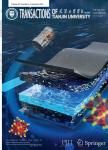Arc Characteristic and Metal Transfer of Pulse Current Horizontal Flux-Cored Arc Welding
Arc Characteristic and Metal Transfer of Pulse Current Horizontal Flux-Cored Arc Welding作者机构:School of Materials Science and Engineering Tianjin University Tianjin 300072 China Tianjin Key Laboratory of Advanced Joining TechnologyTianjin 300072 China China National Petroleum Offshore Engineering Co. LtdTianjin 300452 China
出 版 物:《Transactions of Tianjin University》 (天津大学学报(英文版))
年 卷 期:2017年第23卷第2期
页 面:101-109页
核心收录:
学科分类:080503[工学-材料加工工程] 08[工学] 0805[工学-材料科学与工程(可授工学、理学学位)] 0802[工学-机械工程] 080201[工学-机械制造及其自动化]
主 题:Bridge decks Drops Electric arc welding Flux cored arc welding (FCAW) High speed cameras High speed photography Poles Welding
摘 要:In this work, we utilized high-speed video photography to investigate the arc characteristics, metal transfer behavior, and welding spatter of the pulse-current flux-cored arc welding (P-FCAW) process in the horizontal position. The results indicate the presence of a stable “flux pole during both the pulse-on and pulse-off periods when the mean current ranged from 140 to 170 A. The existence of this “flux pole was beneficial for droplet transfer in the “axial droplet transfer mode. With respect to welding spatter, with an increase in the welding current, we observed three kinds of spatter—explosive spatter, rebounded droplet spatter, and scattering spatter. With an increase in the pulse current from 310.6 to 345.6 A, the deflection of the arc reduced from 30.4° to 16.6°, which positively influenced the arc rigidity, particularly in the horizontal position. © 2017, Tianjin University and Springer-Verlag Berlin Heidelberg.



